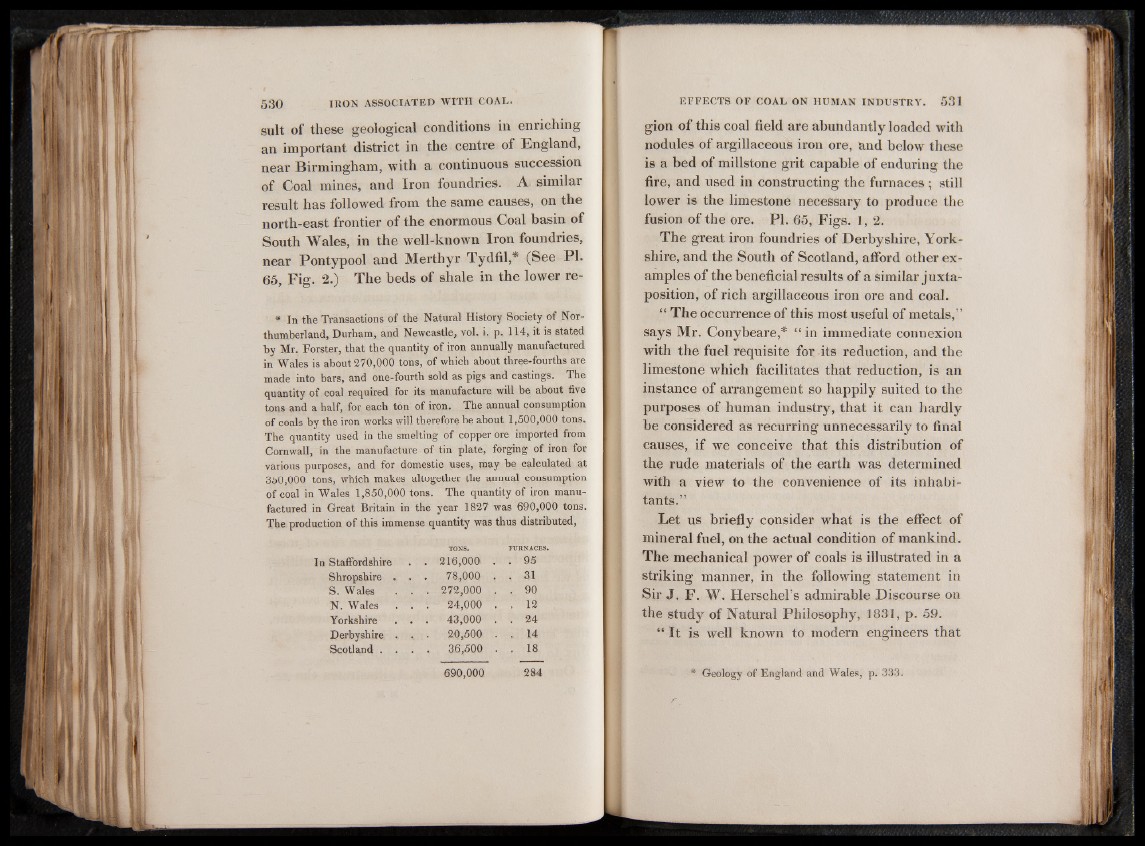
suit of these geological conditions in enriching
an important district in the centre of England,
near Birmingham, with a continuous succession
of Coal mines, and Iron foundries. A similar
result has followed from the same causes, on the
north-east frontier of the enormous Coal basin of
South Wales, in the well-known Iron foundries,
near Pontypool and Merthyr Tydfil,* (See PI.
65, Fig. 2.) The beds of shale in the lower re-
* In the Transactions of the Natural History Society of Northumberland,
Durham, and Newcastle, vol. i. p. 114, it is stated
by Mr. Forster, that the quantity of iron annually manufactured
in Wales is about 270,000 tons, of which about three-fourths are
made into bars, and one-fourth sold as pigs and castings. The
quantity of coal required for its manufacture will be about five
tons and a half, for each ton of iron. The annual consumption
of coals by the iron works will therefore be about 1,500,000 tons.
The quantity used in the smelting of copper ore imported from
Cornwall, in the manufacture of tin plate, forging of iron for
various purposes, and for domestic uses, may be calculated at
350,000 tons, which makes altogether the annual consumption
of coal in Wales 1,850,000 tons. The quantity of iron manufactured
in Great Britain in the year 1827 was 690,000 tons.
The production of this immense quantity was thus distributed,
In Staffordshire
TONS.
. 216,000. .
FURNACES.
. 95
Shropshire . . 78,00.0 . 31
S. Wales . . . 272,000 . 90
N. Wales . . . 24,000 . 12
Yorkshire . . . 43,000 . 24
Derbyshire . 20,500 . 14
Scotland . . . 36,500 . 18
690,000 284
gion of this coal field are abundantly loaded with
nodules of argillaceous iron ore, and below these
is a bed of millstone grit capable of enduring the
fire, and used in constructing the furnaces ; still
lower is the limestone necessary to produce the
fusion of the ore. PI. 65, Figs. 1, 2.
The great iron foundries of Derbyshire, Yorkshire,
and the South o f Scotland, afford other e x amples
o f the beneficial results o f a similar ju x ta position,
o f rich argillaceous iron ore and coal.
“ The occurrence o f this most useful o f metals,”
says Mr. Conybeare,* “ in immediate connexion
with the fuel requisite for its reduction, and the
limestone which facilitates that reduction, is an
instance o f arrangement so happily suited to the
purposes o f human industry, that it can hardly
be considered as recurring unnecessarily to final
causes, if we conceive that this distribution o f
the rude materials o f the earth was determined
with a view to the convenience of its inhabitants.”
Let us briefly consider what is the effect o f
mineral fuel, on the actual condition o f mankind.
The mechanical power o f coals is illustrated in a
striking manner, in the following statement in
Sir J . F . W. Herschel’s admirable Discourse on
the study of Natural Philosophy, 1831, p. 59.
“ It is well known to modern engineers that
* Geology of England and Wales, p. 333.